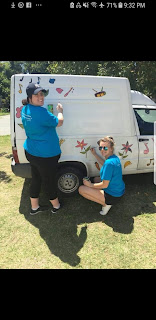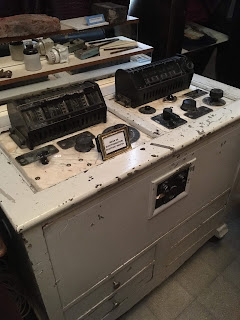Hola chicas y chicos! Many of us are picking up on some simple Spanish terms and using them to improve our effective communication! I’d recommend learning as much Spanish as you can if Buenos Aires is a destination of interest for you (and it should be!!) Not just because of the hot weather, beautiful architecture and incredible food but also for the wonderful and friendly people we’ve met thus far!
Today’s blog is brought to you by Mikayla Ayre and Mary-Beth MacDonald. We are both in the accelerated nursing program at CBU and we’re going to tell you about our busy day. The day started early (6AM for lots of us) and we headed off in our separate directions.
Today, Katie Rogers and I (Mary-Beth) had a once in a lifetime experience when we were chosen to observe an open-heart surgery on a pediatric patient that took place at Hospital Gutierrez. The patient was an 18-month-old girl with hypoplastic left heart syndrome. This means she was born with only the right ventricle of her heart and an underdeveloped aorta. This was causing excessive work for the single ventricle and was allowing oxygenated and non-oxygenated blood to mix leading to heart failure, fatigue and slow growth. The surgeons explained that 40% of the cardiac surgeries performed at are Hospital Gutierrez due to single ventricle defects but that this procedure was very rare. The surgery involved using a patch and the bottom part of the patient’s pulmonary artery to create a larger aorta and attaching the superior vena cava to the pulmonary artery. This allows deoxygenated blood from the body to become oxygenated by the lungs without entering the heart, therefore reducing the workload on the single ventricle. We were able to see the one- way direction of blood flow on a transesophageal echocardiography (TEE) in the operating room. After 6 long hours, the surgery was complete and successful! Its hard to describe the feeling and emotion of watching a tiny heart begin to beat again after being taken off machines—so just WOW! We had the chance to accompany her to a recovery/intensive care unit with only 5 beds before we had to say our goodbyes and meet up with the rest of the group at Hospital Rivadavia. Everyone was excited and curious (and maybe a little envious) about our day and we were thrilled to share our stories.
 Photo of the OR
Photo of the OR
Mikayla here! While Mary-Beth and Katie were having their once in a lifetime experience, the group of students who are assigned to Roffo hospital (Cancer Research Hospital) met with a psychologist who works at Roffo, Dr. Yanina Gabriela Piccinni, to discuss art therapy and positive psychology. Every session starts with a bit of meditation, focusing on the heart and your breathing, and visualizing the colors that radiate from your heart. The patients use the inspiration from this exercise to create art through drawings or paintings. Music is usually played while the patients draw/paint. Dr. Piccinni guided us through a short art therapy session so we could better understand. During our session she played the Beatles (one of my faves!) And I found that a mood booster in itself! It was interesting to find out that art therapy has to be conducted by a psychologist due to the emotions that may surface during therapy that need to be properly assessed by a professional so that the client will be able to work through their feelings. Dr. Piccinni also said that encouraging the client to change the color they are using may affect their mood. For example, if they are drawing with black or dark colors to encourage them to use brighter colors like yellow and their mood may improve. The whole therapy is based around focusing on the strengths and the positive aspects of the person rather than their illness. This is a very important concept we have seen many times at Roffo. It's very important to look at the person as a person and not just their illness as we have learned in nursing school. Here, they focus on six strengths developed by a doctor named Selligman. These strengths are wisdom, courage, humanity, transcendence, justice, and moderation. I found this presentation very insightful and we can definitely think about these strengths when nursing at home, and possibly advocate for more services in our community such as art therapy!

The art therapy presentation
Art therapy demonstration
A meaningful quote
We said goodbye to the fantastic staff and volunteers at Roffo, and made our way to Pechoue on foot! Pechoue is a program run through the hospitals in Argentina. It is for youth with mental health issues who need help reintegrating back into society and the work force. At Pechoue, trained volunteers teach the clients life and job skills such as administration, finances, farming, and gardening. The clients work 4 days a week with Tuesday being a rest day and weekends off, they get paid a small sum of money for their work until they can leave Pechoue and find a job. However some clients do return as volunteer staff. We were not able to participate one on one with the clients since the volunteers require extensive training, however we helped out by making “eco-blocks". Eco-blocks are used to replace traditional wooden fencing between crops since wood degrades easily in this climate and the nails falling to the ground pose a safety hazard. Eco-blocks are large plastic bottles that are stuffed with plastic wrappers and styrofoam that would normally be thrown away. This gives the bottles firmness and weight to be able to use them as fencing. It's a pretty cool way to reuse trash if you ask me! And since the plastic doesn't break down, it lasts for a very long time!

Belinda packing her "eco-block"
A finished "eco-block"
We hopped on a bus to our next stop: Rivadavia hospital for some sexual education. Mary-beth and Katie met us there with huge smiles on their faces from their awesome experience in the OR. Daniel, one of the physicians at the hospital, discussed with us the problems the population here faces in regards to reproduction. In our population back home, our biggest issue is STIs related to the lack of condom use due to the more common use of birth control pills as contraceptives. However, here the problem is more basic. Many people do not use contraceptives or are not educated on the availability of contraceptives or proper use, so the amount of babies being born per year is very high, with 700 000 babies born last year. They also have an issue here with teenage pregnancy that could possibly be related to private catholic schools not teaching sexual education, and parents keeping their children home from public school on the days sexual education is happening. However, there are many forms of contraceptives available here in health clinics, schools, and hospitals such as “the pill" and condoms. We even had a demonstration by our very own Lindsay Kelly on how to properly put on a condom and explaining how to check if it is still good to use (good expiry date, wrapper intact, etc.). It was great practice to educate the class on condom use to practice for when we would educate patients. Good job Lindsay!

Sexual education
Friday evening, we had our first rainfall (and most of us were happy to see a slight shift from the heatwave.) A crowd gathered on the rooftop to watch an amazing lightning show while some others took in the loud thunder crashes from the comfort of their rooms!
Some of us learned just how kind Argentinians really are when they returned Kara’s cellphone that was accidentally left behind in a cab. Near miss!
Some students did some exploring after clinical and found a really cool antique shop!
Johnny at the antique shop
We are all missing our families (humans and pets included) back in Canada but we’re not quite ready to return just yet. We’d like to thank you all for following along and we can’t wait to see what week 2 has in store for us.
Ciao!












































